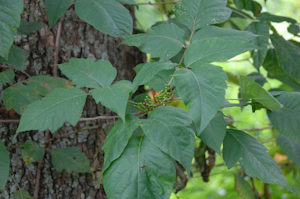Vol. 13 Issue 3, Fall 2008
By Kerry Bzdyk

Photo by Nicole Hamilton
It’s the plant we all love to hate. If it’s growing in our yards, we just want it gone. But this native plant, about which myths abound, does have some positive attributes.
Poison Ivy (Toxicodendron radicans) is a deciduous plant that is native to North America and a member of the cashew family. It is most recognizable by its configuration of three leaflets. It emerges in the spring with reddish leaves that turn shiny green during the summer and finally to red, orange, or yellow in the fall.
It can grow as a vine along the ground, as a small shrub, or it can climb up trees, walls, and fences, attaching itself with its distinctive, hairy looking and woody stem. The small white, sweet-smelling blossoms appear in June followed by clusters of white berries in July. These berries are eaten by birds, deer, and rodents, all of which help to reseed new plants.
Poison Ivy is a master of disguises and can appear very different depending on the conditions in which it is growing. It prefers edges of wooded areas, but is quite adaptable to survive a variety of habitats. The leaflets vary in size and can be notched or smooth edged. It can be very dark green or pale. It is worth learning to recognize in all its forms and is best avoided because of its toxic oil. The website http://www.poison-ivy.org/ has some great pictures of poison ivy in its varied appearances. One of the more distinctive features is the aerial roots that look almost hairy and can be seen on the climbing version.
It is the oil (called urushiol) in Poison Ivy that causes the contact dermatitis rash in sensitive people (it is also important to note that even non-sensitive individuals can develop sensitivity after repeated exposures). Reactions can vary from a small rash to a trip to the emergency room. One of the most dangerous types of exposure is breathing the smoke from burning plants. This can be life threatening.
The oil is present in most parts of the plant, which explains why you can get the rash even during the winter if you come in contact with the dormant vine. The oil can be spread to humans through direct contact with the plant or indirect contact, such as petting a cat or dog who has brushed against the plant. The worst case I ever had I got from my cat!
If you know that you have been exposed to Poison Ivy, you may avoid the reaction by getting the oil off your skin before it has time to penetrate (usually an hour or two). What is commonly recommended and has always worked in our house is a cool shower with plenty of water and a soap that will cut through the oil (we use dish detergent!). Once you have the rash, there are prescription remedies available that can speed up the healing process and reduce the severity.
Still waiting to hear about its good points? While I admit that this is a tough plant to love, its fruit is very popular with wildlife and it really is one of the prettiest vines in the fall when it turns amazing colors. My favorite is an old vine that is climbing a huge white pine not far from my home. The bright red-orange leaves within the cloak of feathery evergreen make a spectacular sight. So look for it this fall and enjoy the visual effect — from a distance!
If you let poison ivy grow in an area where you will not come in contact with it, you will have a huge diversity of birds, especially those migrating from our area to South America and other points south, gobbling up the berries. Of all the wildlife plants, this one has one of the highest values to birds not only as they make their long migrations but also as our winter birds work to survive through our coldest seasons.
Resources:
http://poisonivy.aesir.com/view
http://www.poison-ivy.org/

